Photo: Nicolae Stoian
With the prospect of no Carlos Valdes in the back line to face Real Salt Lake, last week we looked at the defender statistics for the Philadelphia Union through the first 24 games of the season. In doing so, the numbers confirmed what was already a generally held opinion: the Union defense has suffered since the departure of Jordan Harvey.
With the prospect of Faryd Mondragon being unavailable for two to four weeks following a finger injury that resulted in the Union captain being unable to play in the second half against RSL, we now take the opportunity to look at what the goalkeeping statistics reveal.
In our look at the Union defense, we described a series of defender categories and the discussion below will use these categories. Through the first 24 games, broadly speaking, the Union had two starting backlines: the Jordan Harvey-Carlos Valdes-Danny Califf-Sheanon Williams line that started the season and the Gabriel Farfan-Valdes-Califf-Williams line that began with Harvey’s transfer to Vancouver. These two starting back fours can be further broken down into three more groups: the starting back four with Harvey and with substitutions; the starting back four with Gabriel and one or two fill-in defenders; a Harvey or Garfan back four in which a starting defender is ejected. In the match against RSL, the Union employed a new back four combination with Michael Farfan in at left back for Gabriel Farfan and Stefani Miglioranzi in for Carlos Valdes. In the discussion below, this new backline will be included in the fill-in defender category.
Between the posts
Faryd Mondragon was arguably the most important Union acquisition for the 2011 season with unquestioned leadership and goalkeeping skills. Much of why the Union are in contention for a playoff spot can be directly linked to him.
In the first twelve games of the season, the Union and Mondragon posted a 6–3–3 record, recording four shutouts while allowing ten goals for an average of .83 goals allowed per game. In the following 13 games, the Union and their goalkeeper posted a 2–4–7 record with three shutouts while allowing 16 goals for an average of 1.23 goals per game. The Union are now winless in the last six games with three losses and three draws and they have not recorded a shutout since July 17 against New England, also the last time they recorded a win and the last league game in which Carlos Ruiz wore the Union colors. Through the first 12 games of the season, the Union allowed more than one goal twice. In the last 13 games, they have allowed two goals six times.
The chart below lists Mondragon’s numbers in eight categories: goals allowed; attempts on goal; shots on goal; saves; successful passes; unsuccessful passes, passing accuracy percentage and save percentage. (Click on each chart in this post to see it in full size.) Two trend lines are indicated on the chart. The bottom trend line indicates goals allowed and it is rising. The top trend line indicates passing accuracy percentage, and it is falling.
on goal; saves; successful passes; unsuccessful passes, passing accuracy percentage and save percentage. (Click on each chart in this post to see it in full size.) Two trend lines are indicated on the chart. The bottom trend line indicates goals allowed and it is rising. The top trend line indicates passing accuracy percentage, and it is falling.
Compared to the league, Mondragon is at present 14th in the number of shots faced, 16th in the number of saves and 12th in number of goals allowed. His goals against average of 1.06 is among the best in the league. Mondragon’s win percentage is 32 percent while his save percentage is 61 (.606/7; see below) percent.
Mondragon with Harvey in the back four
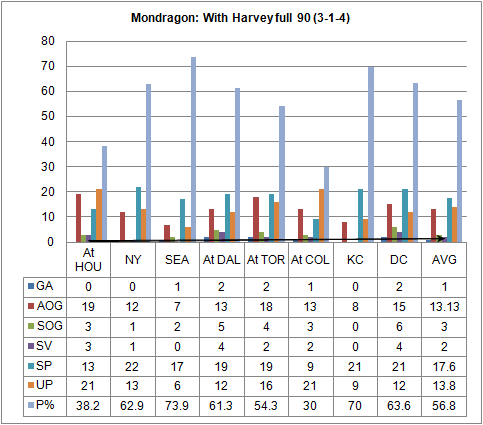 Mondragon played with the backline that featured Harvey for the full 90 minutes in eight games for a 3–1–4 record with three shutouts. He allowed eight goals, an average of one goal per game, compared to the season average of 1.04 goals per game. Nevertheless, the trend line for goals allowed is rising in those eight games. During games with the Harvey back four for the full 90 minutes, Mondragon averaged two saves from an average of three shots on goal compared to the season average of 1.8 saves from 2.84 shots on goal.
Mondragon played with the backline that featured Harvey for the full 90 minutes in eight games for a 3–1–4 record with three shutouts. He allowed eight goals, an average of one goal per game, compared to the season average of 1.04 goals per game. Nevertheless, the trend line for goals allowed is rising in those eight games. During games with the Harvey back four for the full 90 minutes, Mondragon averaged two saves from an average of three shots on goal compared to the season average of 1.8 saves from 2.84 shots on goal.
While a goalkeeper is most obviously judged on how well he prevents goals, a sense of his contribution to a team’s offense can be glimpsed through his passing accuracy, which would include everything from goal kicks, to punts, to more commonplace rolled or kicked passes to defenders or beyond. What is striking for a team that strives to play a possession-oriented game—and this will be repeated throughout all of the categories—is how hit-or-miss Mondragon’s passing accuracy numbers are, ranging in this instance from a low of 38.2 percent against Houston away (win) to 70 percent against Kansas City at home (draw) for an average is 56.8 percent compared to 55.4 percent overall.
Mondragon with Harvey: substitutions 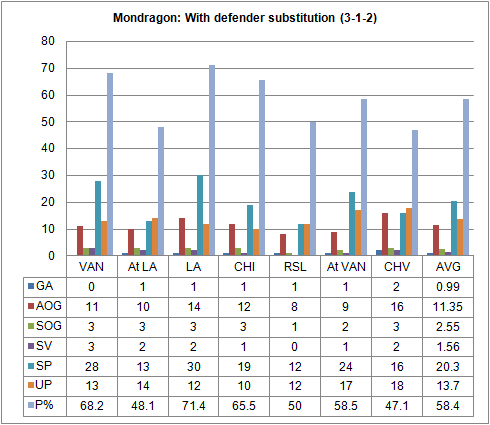
In the seven games in which a defender was substituted—in each case it was Jordan Harvey who was replaced except for the game in LA in which Sheanon Williams was subbed out—Mondragon’s goals allowed average drops slightly below the 1 goal average in the previous category to .99. The average number of saves declines to 1.56 when a defender was substituted, compared to 2 saves when Harvey played the full 90 and 1.8 saves overall. This is because the shots on goal average is smaller—Mondragon had to make fewer saves on average—which is itself related to the fact that, with the exception of the Vancouver game at home, substitutions were made when the Union had already conceded a goal and was fighting to equalize or to get a go-ahead goal.
Mondragon’s passing accuracy in games in which a defender was substituted is slightly better at 58.4 percent compared to 56.8 when Harvey played the full 90 minutes and 55.4 percent overall.
Mondragon with Harvey complete
When looking at the complete numbers for Mondragon with all of Harvey’s games included, the goals allowed average is .936 goals per game, better than the season average of 1.04 and the individual averages for when
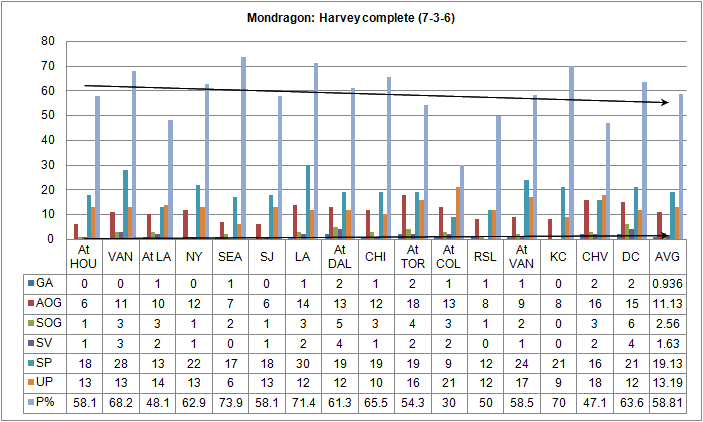 Harvey played the full 90 minutes and when a defender was substituted. This is because of the five shutouts recorded during games which Harvey played, including the match against San Jose at home that saw Harvey ejected (which will be included in another category below). Still, looking at Mondragon’s numbers with Harvey on the field, the trend line for goals allowed is rising. Nevertheless, the average of 11.13 attempts on goal is lower than the season average of 11.9, as is the shots on goal average of 2.56 compared to 2.84 overall. The average of 1.63 saves with Harvey is also lower than the season average of 1.8 saves. All in all, it appears that Mondragon had to make fewer saves, and therefore allowed fewer goals, because the backline with Harvey better prevented opponents from creating attempts on goal and shots on goal.
Harvey played the full 90 minutes and when a defender was substituted. This is because of the five shutouts recorded during games which Harvey played, including the match against San Jose at home that saw Harvey ejected (which will be included in another category below). Still, looking at Mondragon’s numbers with Harvey on the field, the trend line for goals allowed is rising. Nevertheless, the average of 11.13 attempts on goal is lower than the season average of 11.9, as is the shots on goal average of 2.56 compared to 2.84 overall. The average of 1.63 saves with Harvey is also lower than the season average of 1.8 saves. All in all, it appears that Mondragon had to make fewer saves, and therefore allowed fewer goals, because the backline with Harvey better prevented opponents from creating attempts on goal and shots on goal.
Looking at passing accuracy, the average with Harvey of 58.81 percent is higher than the season average of 55.4. Regardless of the better numbers, this still means that Mondragon turned over possession more than 40 percent of the time.
Mondragon with Garfan
With the departure of Jordan Harvey, Gabriel Farfan, had already filled in for Harvey against Portland away following Harvey’s red card against San Jose at PPL Park, became, until the Real Salt Lake game away, the Union’s starting left back. Five of Garfan’s eight starts occurred on the road and, given the Union’s less than stellar road record, it will come as no surprise that Mondragon’s numbers in games featuring the converted midfielder suffer.
 In games in which the backline of Garfan-Valdes-Califf-Williams have played the full 90, the Union’s record is 1–1–2 with one shutout. In those games, Mondragon faced an average of 11.5 attempts on goal and 2.5 shots on goal, slightly poorer than the average for all of Harvey’s games of 11.3 attempts on goal and 2.56 shots on goal but better than thea season averages of 11.9 attempts on goal and 2.84 shots on goal.
In games in which the backline of Garfan-Valdes-Califf-Williams have played the full 90, the Union’s record is 1–1–2 with one shutout. In those games, Mondragon faced an average of 11.5 attempts on goal and 2.5 shots on goal, slightly poorer than the average for all of Harvey’s games of 11.3 attempts on goal and 2.56 shots on goal but better than thea season averages of 11.9 attempts on goal and 2.84 shots on goal.
Mondragon averaged 1.25 saves with the standard Garfan backline and 1.25 goals allowed, compared to the Harvey backline of 1.63 saves and .936 goals allowed and the season averages of 1.8 saves and 1.04 goals allowed.
Mondragon’s passing accuracy is significantly lower with the Garfan backline, ranging from a low of 34.3 percent against Portland away to a high of 50 percent against Houston at home for an average of 41.1 percent. This is compared to the Harvey average of 58.81 percent and the season average of 55.4 percent.
Mondragon with fill-in defenders
Three of Garfan’s eight starts have included fill-in defenders. The back four started against Real Salt Lake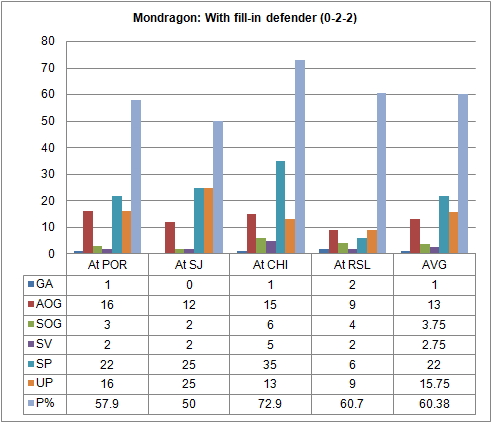 included two fill-in defenders if Garfan is considered the current starting left back.
included two fill-in defenders if Garfan is considered the current starting left back.
Given the makeshift nature of such a backline, it is not unexpected to see the average number of attempts on goal rise to 13, compared to 11.5 with the standard Garfan backline, 11.13 with the standard Harvey backline and 11.9 for the overall season average. With more attempts on goal comes a rise in the average number of shots on goal to 3.75 and an increase in the average number of saves made by Mondragon to 2.75. Interestingly, however, the average number of goals allowed drops to 1, slightly above the Harvey average of .936 but better than the standard Garfan backline average of 1.25 and the season average of 1.04. This despite the two goals allowed against RSL, the highest number of goals allowed in any of the games with a fill-in defender.
Mondragon’s passing accuracy percentage also rises during games with a fill-in defender to 60.38 percent, higher than the 41.1 percent with the standard Garfan back four, the 58.81 percent average for all of the Harvey games and 55.4 percent overall.
Mondragon with Garfan complete
Mondragon’s numbers with the Garfan back four are poorer than those with the Harvey back four and the season average overall. Additionally, as is the case with both the Harvey backline and the overall season numbers, the trend lines for goals is rising and for passing accuracy percentage is declining.
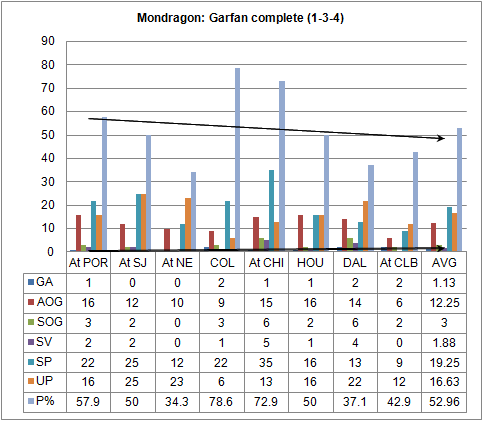 Looking at the average number of attempts on goal, the average for all of the games in which Garfan played is 12.25, compared to 11.13 with the Harvey back four and 11.9 overall. The average number of shots on goal rises to 3, compared to 2.56 with Harvey and 2.84 overall, while the average number of saves made by Mondragon is 1.88 compared to 1.63 with Harvey and 1.8 for the season. While the average for goals allowed is 1.04 for the season and .936 with the Harvey backline, the average number of goals with the Garfan backline is 1.13.
Looking at the average number of attempts on goal, the average for all of the games in which Garfan played is 12.25, compared to 11.13 with the Harvey back four and 11.9 overall. The average number of shots on goal rises to 3, compared to 2.56 with Harvey and 2.84 overall, while the average number of saves made by Mondragon is 1.88 compared to 1.63 with Harvey and 1.8 for the season. While the average for goals allowed is 1.04 for the season and .936 with the Harvey backline, the average number of goals with the Garfan backline is 1.13.
Mondragon’s passing accuracy with the Garfan back four is 52.96 percent. In other words, nearly 50 percent of Mondragon’s passes resulted in a change of possession. This seems to be a result of the replacement of a possession oriented approach to a more kick-and-run approach, particularly when one considers that in five of the eight games with the Garfan back line, the Union was scored on first (at Portland, Colorado, Dallas, at Columbus), or was tied with their opponent (at San Jose, at Chicago—against Houston the Union conceded a late equalizer) and looking for a game winner.
Mondragon with Harvey backline vs with Garfan backline
As was described in the post on the Union defense, it is not surprising that Mondragon’s numbers with a backline that includes a converted midfielder playing the majority of his games on the road, and more than a third of his games with a makeshift back line, are not as good as with those of a backline that included a journeyman left back. Nor can the blame for the ongoing offensive slump, even with Mondragon’s passing accuracy numbers, be laid at the feet of the post-Harvey backline.
(Regarding Mondragon’s passing accuracy percentages, I have not been able to find a source that lists these numbers for goalkeepers across the league. So, where Mondragon stands compared to other keepers I cannot say. Nonetheless, doesn’t it seem unwise to rely on punts that typically result in turning over possession more than 40 percent of the time rather than building possession up the field beginning with short passes to the backline? Perhaps not doing so speaks to a lack of confidence in the Union midfield?)
As has been mentioned, the trend lines for goals allowed have risen throughout the season. This is immediately apparent when you look at Mondragon’s save percentage over the course of the season. (Save percentage is calculated by dividing the number of saves by the number of shots on goal. When I calculated the save percentage on a game-by-game basis, the current save percentage of .607 percent is different from the .606 percent currently shown on the Union’s website. I cannot account for the .001 difference.)
percentage is calculated by dividing the number of saves by the number of shots on goal. When I calculated the save percentage on a game-by-game basis, the current save percentage of .607 percent is different from the .606 percent currently shown on the Union’s website. I cannot account for the .001 difference.)  Of the 14 goalkeepers in the league who have played 20 or more games and the eight who have played 25 or more games, Mondragon save percentage comes in last in both groups. Ahead of him are the goalkeepers for the first, second and third place teams in the Eastern Conference, the second, third and fourth place teams in the Western Conference as well as one current wild card playoff contender from the West. (Josh Saunders, who replaced Donovan Ricketts in net when he was injured for first place in the Western Conference leading LA Galaxy, has a save percentage of .727 through 15 games while Ricketts’ is .805 through 14 games.)
Of the 14 goalkeepers in the league who have played 20 or more games and the eight who have played 25 or more games, Mondragon save percentage comes in last in both groups. Ahead of him are the goalkeepers for the first, second and third place teams in the Eastern Conference, the second, third and fourth place teams in the Western Conference as well as one current wild card playoff contender from the West. (Josh Saunders, who replaced Donovan Ricketts in net when he was injured for first place in the Western Conference leading LA Galaxy, has a save percentage of .727 through 15 games while Ricketts’ is .805 through 14 games.)
 If the save percentage is calculated on a game-by-game basis for each of the 16 games Mondragon played with the Harvey back four as opposed to the cumulative season average, the save percentage for the final game in which Harvey played, DC away, is .651 percent.
If the save percentage is calculated on a game-by-game basis for each of the 16 games Mondragon played with the Harvey back four as opposed to the cumulative season average, the save percentage for the final game in which Harvey played, DC away, is .651 percent.
Doing the same on a game-by-game basis for the eight games in which Mondragon played with the Garfan back four and ending with Garfan’s last start against Columbus away, the save percentage is .625.
Mondragon’s save percentages as independently calculated for the Harvey and Garfan backlines are each better than his current save percentage of .606/.607. The two saves from four shots on goal recorded by Mondragon against RSL, a save percentage of .500, certainly didn’t help his save percentage on the season.
In the beginning of the season, match reports on the PSP often noted that while Mondragon’s leadership on the pitch was readily apparent to all, how he was at actually making saves was difficult to judge because he simply wasn’t being tested—the defense wasn’t allowing opponents to get many shots on goal. Looking at the first six games of the season, Mondragon faced 13 shots on goal, an average of 2.17 per game, allowing only two goals, an average of .333 per game, while recording three shutouts for a 4–1–1 record. Over the last six games of the season, Mondragon has faced 23 shots on goal, an average of 3.83 per game, allowing 10 goals, an average of 1.67 per game, while recording no shutouts for a 0–3–3 record.
Was the Union’s schedule easier in those first six games? It appears so. Houston has greatly improved from where they were at the beginning of the season, but a road win on opening day is still a significant achievement. Also on the schedule were LA on the road and New York and Seattle at home, tough games all that finished with a mixed record. What the Union did in the beginning of the season that they have not been able to do consistently since June is defeat weaker teams. The last six games have featured first and now third place teams in the East and the third, fourth and fifth place teams in the West. Meanwhile, a win was to be expected in Chicago and was not delivered. Looking at the results from the last six games, only the game with Dallas was in anyway positive in its outcome and that game ended as a draw.
The impact of the loss of Jordan Harvey on the Union defense, and thus on Mondragon’s numbers, also cannot be minimized, but it can be overstated. Already by the midway point of the season in terms of games played so far, and so before Harvey’s departure, the Union defense was beginning to show signs of weakening. This, along with the ongoing inconsistent performances from the Union offense—the Union currently averages 1.24 goals per game, just below Chicago and just above New England and only three other teams—combined with Ruiz’s absence for international duty and eventual departure, as well as the ongoing inconsistent play from the midfield, begin to describe a team that is playing more like the incomplete second year team that it is rather than the team that, largely through unexpectedly and (apparently) unsustainably outstanding defensive work, as well as a decent measure of good fortune, created results greater than the sum of its parts. In the end, when the Union defense—either through personnel changes, illness, suspensions, fatigue or statistical reality—began to show that it was in fact mortal and capable of mistakes, the Union offense has not delivered the goals needed to compensate.
The Philadelphia Union would not be where they are at the moment—despite the current slump they are still realistically in contention for the playoffs—without both the leadership and the goalkeeping skill of Faryd Mondragon. With Mondragon expected to be out two to four weeks, his leadership will still be essential for the success of the Union in the remainder of the season. All we can hope for is that Zak MacMath has learned his lessons well.
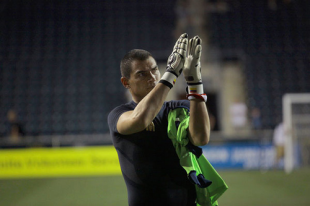

i’m not sold on mondragon. i think he’s getting too much credit for what the defense has has done. he deserves some of it but not an exceptional amount. when you compare his numbers to seitz/knighton the only thing that’s really different is the sog/ga most of which i would chalk up to the defense.
I am also not completely sold on Da Dragon…Im hoping that Zac Mac will be a solid shot stopper with Dragon’s voice and organizational skills.